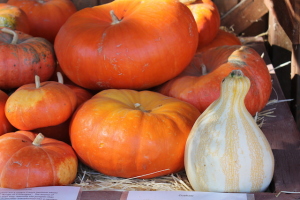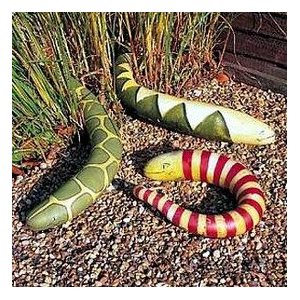The first couple of weeks in June is the perfect time to get in a crop of any gourd or squash for fall harvest. This will give your heirloom pumpkins and gourds plenty of time to ‘cure’ for Halloween. It’s also a great time to plant another crop of beans, corn and late season tomatoes. The weather has warmed up and so has the soil. It’s not necessary to make a mound to plant squash seeds of any kind unless your soil doesn’t drain well. If that’s the case I recommend a good amount of compost should be dug into the soil before planting.
Plant the seeds about 1 1/2″ – 2″ deep and water well, I like to sprinkle the soil every day until the seeds emerge. As the plant begins to grow you’ll want to water less often, let the soil begin to dry out, and water deeply when you do water. Keeping the leaves dry will help prevent many diseases such as powdery mildew which can have an adverse affect on the production of the plants and fruit.
It’s easy to keep the soil from splashing up on the plants if you mulch around them. I put down a thick layer of newsprint, black and white parts only, and then I cover that with straw. This is a great way to prevent weed seeds from sprouting and to help keep moisture in the soil. The worms love the newsprint and they will help to aerate the soil as well.
A general fertilizer and compost will keep your plants healthy as the gourds start to grow. Small pumpkins, gourds and squashes can be plant on a trellis to save room. The large pumpkins have vines that can run for 30 feet or so; before fruit develops or when it’s very small, wrap the vines around the base of your corn plants or sunflowers.
If you like to pick the blossoms for cooking, pick the males flowers as there are many more of those than the female ones that produce the fruit. The male flowers will have a straight stem coming from the vine while the female flowers have a little bulge around the base of the flower, which turns into the squash or pumpkin. All squash flowers can be used in cooking, be careful when picking that you don’t accidentally take a bee into the house. Open the flower very gently and the bee should fly out to another plant. I have never been stung in all my gardening years by a bee! In fact I plant lots of flowers throughout my garden to attract them, bees pollinate a whopping 1/3 of our crops so they are essential to the garden. Don’t use any chemical sprays in the garden to avoid killing beneficial insects. Pick off beetles or squash bugs and drop them in a bowl of soapy water. If you do have to spray for any pest use an insecticidal soap such as Safer brand or Dr. Earth. Plant sunflowers along with the squash/gourds and the bugs will have a tendency to stay on the sunflowers rather than the squash. Ladybugs are wonderful for snacking up all of the aphids in the garden too!
While your pumpkins, large squash or gourds are small, place them on the straw to prevent them sitting directly on the soil, this will help to prevent rot on the bottom. Also keep an eye out for critter damage, scratches on the surface or gnaw marks from their teeth. I cover my fruit with floating row cover to keep the critters out but let the sunlight in. If you have children or grandchildren have them scratch their name or a simple design lightly onto the surface of the pumpkin and watch it grow as the pumpkin does.
When the vines start to die it’s a sign the pumpkin or gourd is getting ready to harvest. Let the stem near the gourd dry completely and let the shell start to harden. If you can press the outside and the skin ‘gives’ a little, it’s not quite ready. When it is cut the vine leaving a good amount of the stem attached and pick the pumpkin up from the base, never by the stem.
Store your squash, pumpkins and gourds out of direct sunlight and in a cool area. Many times pumpkins and gourds will last for long periods of time, I had a few that lasted more than a year! Hard shelled squash will store quite a long time, just remember the softer the shell, the less shelf life it will have.
I think the sugar pumpkins have the best flavor for use in recipes but I like to grow a variety for fall displays and of course for All Hallows Eve! The pumpkins I use for decoration I cut up and save the seed when I’m done and place the chopped up squash in the compost pile. Dry the seed on a parchment lined baking sheet until completely dry and then store in a dry, cool place such as your pantry.
And now that your summer crops are all growing along very well, it’s time to think about planting a fall garden, the best time to grow in Southern California, if you ask me!
Mangia!


